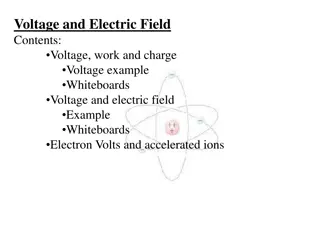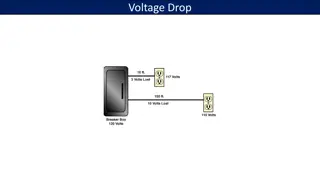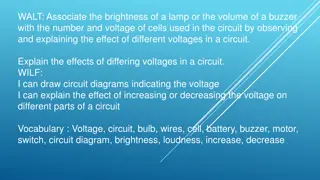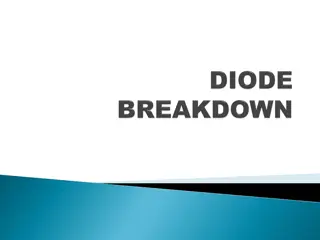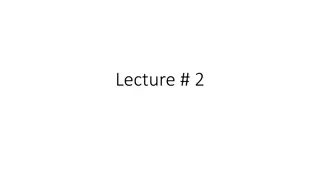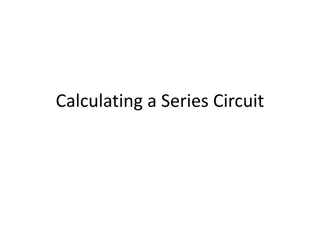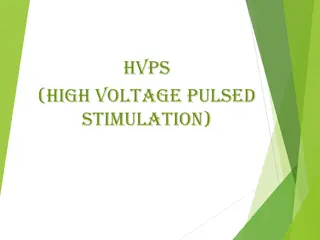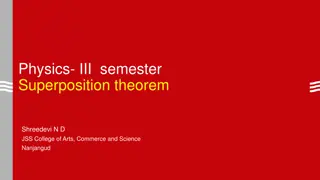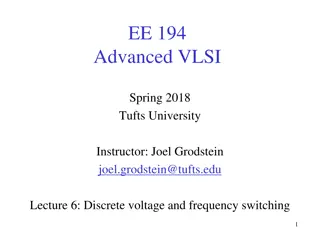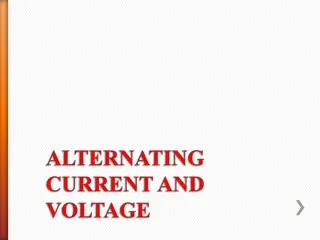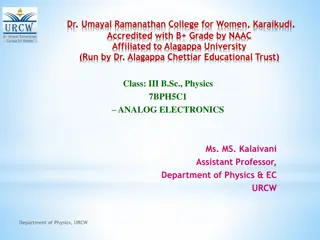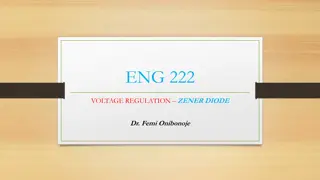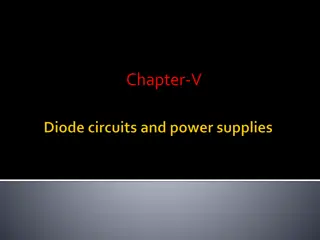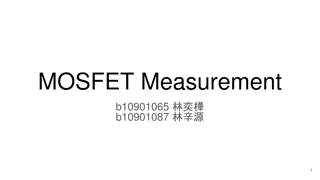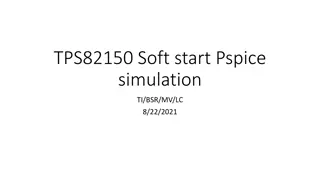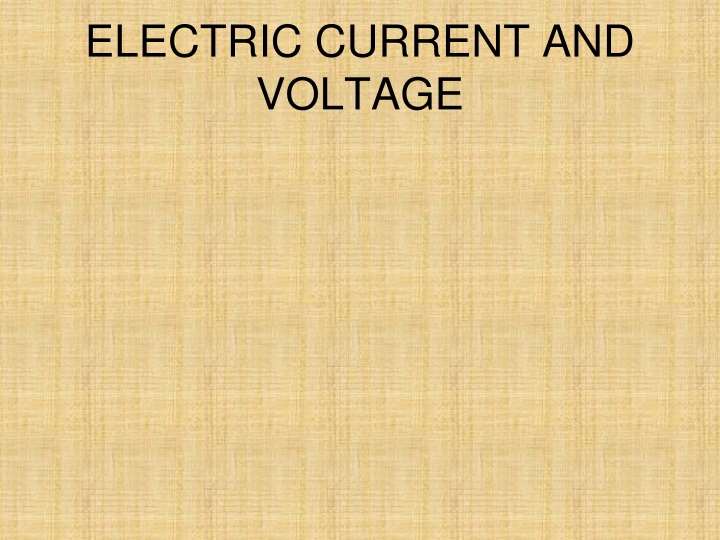
Electric Current and Voltage in Circuits
Learn about electric current and voltage in circuits, including the difference between series and parallel circuits, the role of conductors and insulators, the concept of electric charge, and how to calculate charge passing through a device. Explore the relationship between current, charge, and time in electrical circuits.
Download Presentation

Please find below an Image/Link to download the presentation.
The content on the website is provided AS IS for your information and personal use only. It may not be sold, licensed, or shared on other websites without obtaining consent from the author. If you encounter any issues during the download, it is possible that the publisher has removed the file from their server.
You are allowed to download the files provided on this website for personal or commercial use, subject to the condition that they are used lawfully. All files are the property of their respective owners.
The content on the website is provided AS IS for your information and personal use only. It may not be sold, licensed, or shared on other websites without obtaining consent from the author.
E N D
Presentation Transcript
ELECTRIC CURRENT AND VOLTAGE
Specification Electricity Energy and potential difference in circuits explain why a series or parallel circuit is more appropriate for particular applications, including domestic lighting understand that the current in a series circuit depends on the applied voltage and the number and nature of other components understand that current is the rate of flow of charge know and use the relationship: charge = current time Q = I t know that electric current in solid metallic conductors is a flow of negatively charged electrons know that: voltage is the energy transferred per unit charge passed the volt is a joule per coulomb.
Electrical conductors and insulators An electrical conductor is a material through which electric current flows easily. All metals are conductors. steel mercury paper plastic diamond graphite Complete the table below: copper rubber conductor insulator conductor conductor insulator insulator insulator conductor 1 2 3 Electrical insulators have a very high resistance to the flow of electric current. 4 5 6
Electric charge Electric charge can be either positive or negative. In an atom an electron has a negative charge that is of the same size as the positive charge of a proton. Neutrons have no electric charge. As an atom has the same number of electrons as protons it is uncharged.
Electric current An electric current is the rate of flow of electric charge. An electric current of one ampere (A) flows when a charge of one coulomb (C) passes a point in an electric circuit in one second In metallic conductors (e.g. copper wire) electrons carry negative charge from the negative side of a power supply, around a circuit and back into the positive side. The arrow shows the direction of electron flow.
Charge-current equation electric charge = current x time Q = I x t also:I = Q t and:t = Q I charge current time
Question 1 Calculate the charge passing through a device when a current of 500mA flows for 3 minutes.
Question 1 Calculate the charge passing through a device when a current of 500mA flows for 3 minutes. Q = I x t = 500 mA x 3 minutes = 0.5A x 180s charge = 90C
Question 2 Calculate the current flowing when a charge of 240C flows through a device in 80s.
Question 2 Calculate the current flowing when a charge of 240C flows through a device in 80s. I = Q t current = 240 C 80s current = 3A
Complete: Complete Q I t 60 C 2 A 13 A 5 s 960 C 4 minutes 3 C 50 mA
Complete: Answers Q I t 30 s 60 C 2 A 13 A 5 s 65 C 3 A 960 C 4 minutes 60 s 3 C 50 mA
Voltage A battery gives electrical charge energy. The voltage of a battery is equal to the energy in joules provided when a charge of one coulomb passes through the battery. voltage = energy charge 1 volt is the same as 1 joule per coulomb
Question Calculate the voltage of a battery if it supplies 300 joules of energy to 50C of charge.
Question Calculate the voltage of a battery if it supplies 300 joules of energy to 50C of charge. voltage = energy charge = 300 J 50 C battery voltage = 6V
Complete: Complete Voltage Energy Charge 12V 480J 500J 25C 6V 20C 230V 69kJ
Complete: Answers Voltage Energy Charge 12V 480J 40C 500J 25C 20V 6V 20C 120J 230V 69kJ 300C
Choose appropriate words to fill in the gaps below: Electric current is the rate of flow of electric _______. Electric charge is measured in _________. A battery provides electrical _______ . The amount of energy provided per _________ of electric charge passing is equal to the ________ of the battery. The _______ supply gives 230 ________ to every coulomb of charge. WORD SELECTION: coulombs charge mains joules coulomb voltage energy
Choose appropriate words to fill in the gaps below: Electric current is the rate of flow of electric _______. charge Electric charge is measured in _________. coulombs A battery provides electrical _______ . The amount of energy provided per _________ of electric charge passing is equal to the ________ of the battery. voltage energy coulomb The _______ supply gives 230 ________ to every coulomb of charge. joules mains WORD SELECTION: coulombs charge mains joules coulomb voltage energy
Electric circuits An electric current will only flow if there is a complete, unbroken electric circuit, that contains a power supply. A circuit diagram uses a standard set of symbols to show how electrical components are connected together.
Circuit symbols a cell is required to push electrons around a circuit cell a battery consists of two or more cells battery wires should always been drawn as straight lines wire wire junction switch a switch enables the current in a circuit to be turned on or off
often a light bulb this is used to show whether or not a circuit is on indicator old symbol the indicator symbol is now used light bulb measures electric current in amperes (A) measures voltage in volts (V) ammeter A voltmeter V
a resistor is used to limit the current in a circuit fixed resistor variable resistor a device whose resistance decreases with temperature thermistor a device whose resistance decreases with brightness light dependent resistor (LDR)
a diode only allows current to flow in one direction (indicated by the arrow) diode a diode that emits light when it allows the flow of electric current light emitting diode (LED) a fuse is designed to melt and so break an electric circuit when too much electric current flows fuse a device used to convert electrical energy to heat heater
Electric current flow Electric current flows from the POSITIVE terminal of a power supply around a circuit to the NEGATIVE terminal. In the circuit above the diode is aligned so that it allows current to flow through the radio. The longer thinner line of the symbol for a cell is the positive terminal.
Complete symbol component symbol component A
Answers symbol component symbol component ammeter heater A resistor diode indicator thermistor cell LDR
Question Draw a circuit diagram for the torch shown below.
Series circuits Circuit components are said to be connected in series if the same electric current passes through each of them in turn. 3A 3A 3A 3A 3A 3A 3A The cell and the two lamps are in series with each other and so the same electric current passes through all of them.
In a series circuit all of the components can be controlled by using just one switch. Each component shares the voltage of the power supply and so adding more bulbs in series will cause each bulb to become dimmer.
Parallel circuits The voltage across each component connected in parallel is the same. The voltmeter reading for component X, V1 will be the same as the voltmeter reading for component Y, V2.
In a parallel circuit all of the components can be individually controlled by using separate switches. If one light bulb blows the other bulbs will still carry on working.
Currents in parallel circuits The total current through the whole circuit is the sum of the currents through the separate components. 5A 5A 3A 3A 2A 2A
What are the advantages of connecting two lamps in parallel rather than in series to a power supply? When connected in parallel: 1. the lamps are brighter than when connected in series 2. the lamps can be controlled individually with switches 3. one lamp will continue working even if the other does not
Calculate the currents measured by ammeters A1, A2 and A3 in the circuit below. A1 = 6A A3 A2 = A1 2A A3 = A2
Calculate the currents measured by ammeters A1, A2 and A3 in the circuit below. A1 = 2A 6A A3 A2 = 4A A1 2A A3 = 6A A2
Choose appropriate words to fill in the gaps below: When components are _________ together in series they will all have the same _________ flowing through each of them. When components are connected in parallel to each other they will each have the same _________. Lamps are usually connected in __________ to each other as this allows them to be controlled individually by _________ and if one lamp __ the others can still continue to operate. WORD SELECTION: blows current switches parallel connected voltage
Choose appropriate words to fill in the gaps below: When components are _________ together in series they will all have the same _________ flowing through each of them. current connected When components are connected in parallel to each other they will each have the same _________. voltage Lamps are usually connected in __________ to each other as this allows them to be controlled individually by _________ and if one lamp _______ the others can still continue to operate. WORD SELECTION: parallel switches blows blows current switches parallel connected voltage

